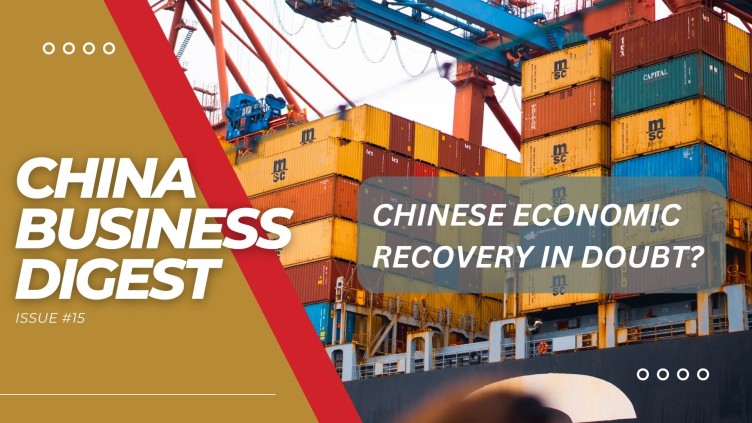Summary:
- What does it take to boost China’s economic recovery?
- Competing in the tech race: why the west needs to negotiate with China, as Ting Zhang explains to Business Leader
- Our thoughts on intellectual property in China
- IP corner: what is CNIPA, or Madrid System, or PCT?
HOT TOPIC

China’s post-pandemic recovery shows signs of losing steam, “imminent” multiple measures to boost growth and recovery likely? What have analysts agreed and disagreed on in this matter? And some highlights about the Chinese economy as it stands now.
It’s becoming clearer that China’s economy did bounce back from Covid, but not as rapid and strong as markets expected. Analysts are watching and thinking: if more data disappoint, will Beijing announce measures to revive economic recovery, and if so, how aggressively.
China is considering at least a dozen stimulus measures including cuts to interest rates to support areas such as real estate and domestic demand, Bloomberg reported on June 12, citing unnamed sources. The plan is still being finalised but announcements are expected soon, it added.
Let’s take a quick look back…
One month ago, newly released data reinforced an anticipation shared by many analysts: Chinese economy has failed to fully recover after removal of zero-Covid policies, industrial output falls short of expectation, recovery is in doubt.
Two weeks ago, after more data came out to disappoint, analysts were heard saying that “confidence is a big problem” , that China’s recovery is losing steam, as evidenced in weak property sales, industrial output and consumption. Indeed, Chinese exports contracted more than expected in May on weaker global demand for the country’s goods at a time when China was trying to mount a strong recovery.
More measures are anticipated if new data disappoints.
The PBOC lowered a key interest rate on June 12 for the first time in 10 months. The rare move of China’s central bank is seen as a response to concerns about the deflationary risks and mounting debt payment pressure by local governments, says Dow Jones. The seven-day reverse repo rate, medium-term lending facility rate, reflects commercial banks’ liability costs.
It is a move to help restore market confidence, signalling possible easing for longer-term rates over the next week and beyond, and adding to the case for urgent policy stimulus to sustain growth, Reuters said.
Some believe it could be the first of a series of measures to boost recovery, including further and broader rate cuts combined with potential fiscal stimulus. Barron’s suggests the contemplated measures are aimed at achieving the country’s 5% growth target for the year and stabilising its economy amid global uncertainties.
“Analysts see the move as an indication officials recognize the damage the economy has suffered over the past couple of years—the challenges included the pandemic, harsh restrictions to control Covid-19, and a crackdown on the property and technology sectors—and the hurdles blocking a stronger recovery,” it says.
Rate cuts may give stock markets a near-term lift, but industrial upgrades remain key for the long-term growth outlook..
COMPETING IN THE TECH RACE: WHY THE WEST NEEDS TO NEGOTIATE WITH CHINA

Is the UK government’s Security & Investment Act and aggressive semiconductor/ technology strategy against China killing the UK tech industry’s global future? Ting Zhang, CEO & Founder of Cambridge-based crayfish.io certainly thinks so.
She recently told Business Leader magazine, the go-to resource for entrepreneurs and business leaders, why the UK should be ‘doing business’ with China, reflecting her recent conversation with Hermann Hauser on this topic.
OUR THOUGHTS ON INTELLECTUAL PROPERTY IN CHINA

What are the main IP protection concerns Western companies have about entering the Chinese market? Should IP protection concerns deter Western companies from entering the Chinese market? What should and could be done to mitigate IP risks in China?
It’s time to think about IP in China in a different way.
Crayfish shares some thoughts here.
IP CORNER

We’ve talked a lot about IP and IP protection in China. Here are four keywords you need to know while securing your IP rights in China: CNIPA, Madrid System, PCT, and Hague System
CNIPA – China National Intellectual Property Administration, where you can file directly in China for your IP. This government body is responsible for matters including:
- Organising the implementation of national IPR strategies, especially strengthening IPR creation, protection and utilisation.
- Protecting IPRs and promoting the construction of IPR protection systems.
- Registering trademarks, patents and geographical indications and making relevant administrative adjudication.
- Guiding trademark and patent law enforcement.
- Coordinating foreign-related IP affairs.
Madrid System – the International Trademark System that provides a convenient and cost-effective solution for registering and managing trademarks worldwide. You can use the Madrid System if you are a national of – or have a domicile or business in – any of the 130 countries covered by the Madrid System’s 114 members, to:
- File a single international trademark application and pay one set of fees to apply for protection in up to 130 countries, and to
- Modify, renew or expand your global trademark portfolio through one centralised system
PCT – Patent Cooperation Treaty, the International Patent System that…
